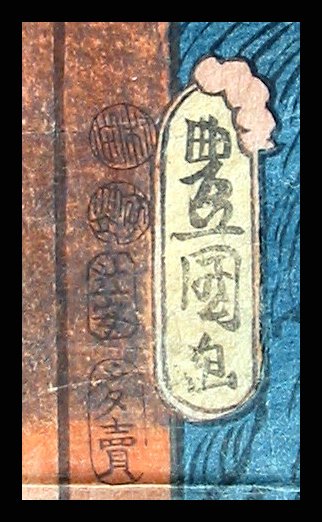
JAPANESE PRINTS
A MILLION QUESTIONS
TWO MILLION MYSTERIES
Ukiyo-e Prints浮世絵版画 |
|
Port Townsend, Washington |
| UTAGAWA TOYOKUNI III | ||
|
三代歌川豊国 |
||
| さんだい.うたがわ.とよくに | ||
|
1786-1865 |
||
| Role (top panel): Sakurahime, i.e., Princess Sakura | ||
| 櫻日女 | ||
| さくらひめ | ||
|
SOLD! THANKS! |
|
|
|
|
|
AN ACT OF FAITH TAKING THE LEAP |
|
There is a print from 1765 by Suzuki Harunobu which shows a young woman floating through the air, clutching an umbrella, descending toward the ground. It is entitled "A Beaty Leaping from the Stage at Kiyomizu Temple." "Leaping from the stage..." is a phrase still used today to describe a bold act.
According to an English supplement to a volume on the Japanese prints in the collection of the Bibliothèque Nationale in Paris this maxim "...is said to originate the ancient practice of jumping from a height to achieve fulfilment of a wish, such as the cure of an illness or success in a love affair..." Eventually the platform at Kiyomizu Temple was incorporated into this description. |
|
TIME AND TIDE WAIT FOR NO MAN AND NEITHER DO THE CHANGES FOUND WITHIN WORKS OF ART |
|
|
|
Anyone who has studied linguistics knows that there are 'laws' governing the changes of words which occur over time. These laws border on the immutable. For example, our knowledge of modern Coptic allows us to extrapolate the sounds of made by the ancient Egyptians. Thus we can make a rough guess at the vocalization of sounds made when reading hieroglyphics aloud.
The same factors are true when it comes to the fine arts and the inevitable changes which take place within a single piece. Modern computer wizards have attempted to write programming which allows us to view the Mona Lisa as it must have appeared at the time of Leonardo. It certainly didn't look then like it does now. A small army of scientists and conservators made extensive studies of the ceiling of the Sistine Chapel before they ever attempted to make even the most microscopic restorations of that masterpiece. And despite all of the contemporary artistic protests this viewer believes that their efforts have given us back something very close to the original vision of Michelangelo.
The reason I am emphasizing the effects of time on artwork and often the degradation of the original materials is because the vertical diptych displayed on this page is no exception. Aside from a discussion of the aesthetics of the oxidation of the orange support columns there is another surprising little detail which could easily be overlooked by a casual glance. Immediately to the left of the signature cartouche in the upper panel is a series of four seals which are almost totally effaced by the effects of time, i.e., the effects of oxidation.
The image below makes this perfectly clear. |
|
|
 |
||||
|
Unidentified Publisher's Seal |

 HOME
HOME